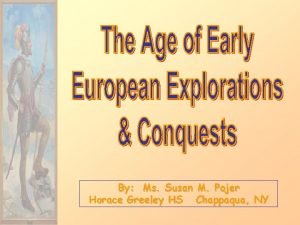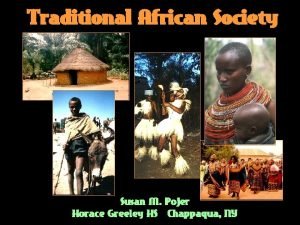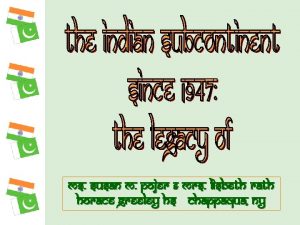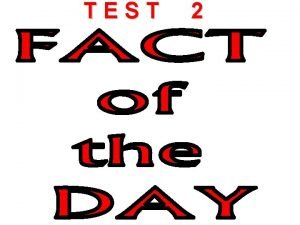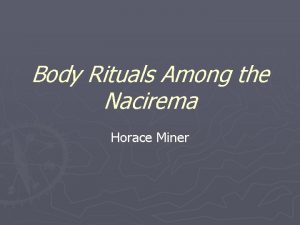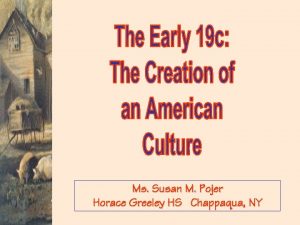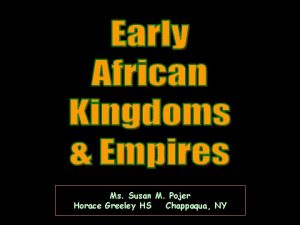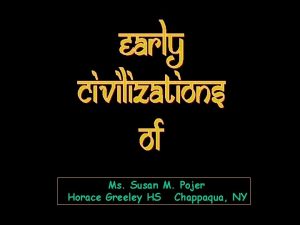Ms Susan M Pojer Horace Greeley HS Chappaqua






























- Slides: 30

Ms. Susan M. Pojer Horace Greeley HS Chappaqua, NY

Theories on prehistory and early man constantly change as new evidence comes to light. - Louis Leakey, British paleoanthropologist


1. 4, 000 BCE – 1, 000 BCE Paleolithic Age: 2. 1, 500, 000 BCE -- 250, 000 BCE 2, 500, 000 BCE to 8, 000 BCE 3. 250, 000 BCE – 30, 000 BCE ( Old Stone Age ) 4. 30, 000 BCE -- 10, 000 BCE

§ “Paleolithic” -->“Old Stone” Age § 2, 500, 000 BCE – 10, 000 BCE § Made tools § hunting ( men ) & gathering (women ) small bands of 20 -30 humans § NOMADIC (moving from place to place)

4, 000 BCE – 1, 000 BCE § Hominids --> any member of the family of two-legged primates that includes all humans. § Australopithecines § An Apposable Thumb

§ HOMO HABILIS ( “Man of Skills” ) § found in East Africa. § created stone tools.

§ Humans § Cave during this period found shelter in caves. paintings left behind. Purpose? ?

1, 6000, 000 BCE – 30, 000 BCE § HOMO ERECTUS ( “Upright Human Being” ) Ø BIPEDALISM § Larger and more varied tools --> primitive technology § First hominid to migrate leave Africa for Europe Asia. § First and to use fire ( 500, 000 BCE )

Are we all Africans “under the skin”? ?

200, 000 BCE – 10, 000 BCE HOMO SAPIENS ( “Wise Human Being” ) Neanderthals ( 200, 000 BCE – 30, 000 BCE ) Cro-Magnons ( 40, 000 BCE – 10, 000 BCE )

NEANDERTHALS: § Neander Valley, Germany (1856) § First humans to bury their dead. § Made clothes from animal skins. § Lived in caves and tents.

NEANDERTHALS Early Hut/Tent

CRO-MAGNONs : § Homo sapiens ( “Wise, wise human” ) § By 30, 000 BCE they replaced Neanderthals. WHY? ? ?


70, 000 BCE – 10, 000 BCE

§ “Neolithic” “New Stone” Age § 10, 000 BCE – 4, 000 BCE § Gradual shift from: Nomadic lifestyle settled, stationery lifestyle. Hunting/Gathering agricultural production and domestication of animals.

§ 8, 000 BCE – 5, 000 BCE § Agriculture developed independently in different parts of the world. Ø SLASH-AND-BURN Farming Middle East 8, 000 BCE India 7, 000 BCE Central America 6, 500 BCE China 6, 000 BCE Southeast Asia 5, 000 BCE

? ? Development of Agriculture ? ?

Why do you think the development of agriculture occurred around the same time in several different places?

Why do some archaeologists believe that women were the first farmers?

§ Growing crops on a regular basis made possible the support of larger populations. § More permanent, settled communities emerged. § 9, 000 BCE Earliest Agricultural Settlement at JARMO ( northern Iraq ) wheat

§ 8, 000 BCE Largest Early Settlement at Çatal Hüyük ( Modern Turkey ) 6, 000 inhabitants § 12 cultivated crops § Division of labor § Engaged in trade § Organized religion § Small military An obsidian dagger

Çatal Hüyük

What role did the food supply play in shaping the nomadic life of huntergatherers and the settled life of the farmers?





Advanced Cities Technology Specialized Record- Workers Keeping Complex Institutions
 American historama lewis and clark
American historama lewis and clark Horace greeley go west
Horace greeley go west Chappaqua jewish population
Chappaqua jewish population Susan pojer
Susan pojer Susan pojer
Susan pojer Susan pojer
Susan pojer Susan pojer
Susan pojer Susan pojer
Susan pojer Susan pojer
Susan pojer Susan pojer
Susan pojer Susan pojer
Susan pojer Susan pojer
Susan pojer Susan pojer
Susan pojer Susan pojer
Susan pojer Steve greeley
Steve greeley Mirko pojer
Mirko pojer Mirko pojer
Mirko pojer Mirko pojer
Mirko pojer Mirko pojer
Mirko pojer Mirko topalovic 7
Mirko topalovic 7 Where was horace born
Where was horace born Ars poetica by horace summary
Ars poetica by horace summary The writer mark twain called the late nineteenth century
The writer mark twain called the late nineteenth century Horace lau
Horace lau Horace and morris but mostly dolores
Horace and morris but mostly dolores Latipsoh meaning
Latipsoh meaning Dorothea dix with my eyes i see
Dorothea dix with my eyes i see Mistress seema rani
Mistress seema rani Horace hp
Horace hp Horace and longinus
Horace and longinus Welcome performance in school
Welcome performance in school



